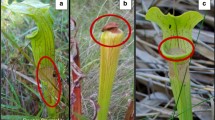Summary
The relationship between total foliar nitrogen content and feeding by Odontota dorsalis Thun. on Black Locust trees (Robinia pseudoacacia L.) was examined via experimental manipulation of foliar nitrogen levels. Trees with high concentrations of foliar nitrogen received more herbivory by adult O. dorsalis, but herbivory by larvae was independent of foliar nitrogen concentration. Late in the growing season, leaf abscission induced by herbivory tends to mask the dependence of herbivory by adults on foliar nitrogen concentration. The percentage of variation in herbivory attributable to foliar nitrogen concentration drops from 20% in June to 2% by August. These observations suggest that variation in the interaction between R. pseudoacacia and O. dorsalis is at least partially conditioned on variation in foliar nitrogen concentration.
Similar content being viewed by others
References
Auclair JL (1976) Feeding and nutrition of the pea aphid Acrytosiphon psium (Harris) with special reference to amino acids. Symp Biol Soc Hung 16:29–34
Boring LR, Swank WT (1984a) Symbiotic nitrogen fixation in regenerating Black Locust (Robinia pseudoacacia L.) stands. For Sci 30:528–537
Boring LR, Swank WT (1984b) The role of Black Locust (Robinia pseudoacacia) in forest succession. J Ecol 72:749–766
Chittenden FH (1902) The leaf-mining locust beetle, with notes on related species. U.S. Bur Entomol Bull 38:70–83
Coley PD (1983) Herbivory and defensive characteristics of tree species in a lowland tropical forest. Ecol Monogr 53:209–233
DeLong DM, Parks TH (1925) U.S. Bureau of Entomology Plant Quarantine. Ins Pest Surv Bull 5:326–327
Dominick CB (1938) Notes on the locust leaf miner, Chalepus dorsalis Thun. J Econ Entomol 31:186–189
Faeth SH, Connor EF, Simberloff D (1981) Early leaf abscission: a neglected source of mortality for folivores. Am Nat 117:409–415
Feeny P (1970) Seasonal changes in the oak leaf tannins and nutrients as a cause of spring feeding by winter moth caterpillars. Ecology 51:565–581
Finn RF (1953) Foliar nitrogen and growth of certain mixed and pure forest plantings. J For 51:31–33
Fowells HA (ed) (1965) Silvics of Forest Trees of the United States. USDA For Serv Agr Handbook 271:642–648
Fox LR, Macauley BJ (1977) Insect grazing on Eucalyptus in response to variation in leaf tannins and nitrogen. Oecologia 29:145–162
Fritz RS (1983) Ant protection of a host plant's defoliator: consequence of an ant-membracid mutualism. Ecology 64:789–797
Hargrove WW, Croasley DA, Seastedt TR (1984) Shifts in insect herbivory in the canopy of Black Locust, Robinia pseudoacacia L., following fertilization. Oikos 43:322–328
Horsfield D (1977) Relationships between feeding of Phenaelus spumarius and the amino acid concentration in the xylem sap. Ecol Entomol 2:259–266
Hurlburt SH (1984) Pseudoreplication and the design of ecological field experiments. Ecol Monogr 54:187–211
Kraft SK, Denno RF (1982) Feeding responses of adapted and non-adapted insects to the defensive properties of Baccharis halmifolia L. Oecologia 52:156–163
Lincoln DE, Newton TS, Ehrlich PR, Williams KS (1982) Coevolution of the checkerspot butterfly Euphydryas chalcedona and its larval food plant Diplacus aurantiacus: larval response to protein and leaf resin. Oecologia 52:216–223
Mattson WJ (1980) Herbivory in relation to plant nitrogen content. Annu Rev Ecol Syst 11:119–161
McNeill S, Southwood TRE (1978) The role of nitrogen in the development of insect/plant relationships. Biochemical aspects of plant and animal coevolution. In: Harborne JB (ed) Proceedings of the Phytochemical Society Symposium, pp 78–98
Moran N, Hamilton WD (1980) Low nutritive quality as a defense against herbivores. J Theor Biol 86:247–254
O'Brien RG, Kaiser MK (1985) MANOVA method for analyzing repeated measures designs: an extensive primer. Psych Bull 97:316–333
Onuf CP (1978) Nutritive value as a factor in plant-insect interactions with an emphasis on field studies. In: Montgomery GG (ed) The Ecology of Arboreal Folivores, Smithsonian Institution, pp 85–99
Plass WT (1972) Fertilizer treatments increase black locust growth on extremely acid surface-mine spoils. Tree Planters' Notes 23:10–12
Poos FW (1940) The locust leaf miner as a pest of soybean. J Econ Entomol 33:742–745
Rockwood LL (1974) Seasonal changes in the susceptibility of Cresentia alata leaves to the flea beetle Oedionychus sp. Ecology 55:142–148
Schroeder LA, Malmer M (1980) Dry matter, energy and nitrogen conversion by Lepidoptera and Hymenoptera larvae fed leaves of black cherry. Oecologia 45:63–71
Scriber JM, Slansky F (1981) The nutritional ecology of immature insects. Annu Rev Entomol 26:183–211
Slansky F, Feeny PP (1977) Stabilization of the rate of nitrogen accumulation by the larvae of the cabbage butterfly on wild and cultivated food plants. Ecol Monogr 47:209–228
Stark RW (1964) Recent trends in forest entomology. Annu Rev Entomol 10:303–324
Stiling PD, Brodbeck BV, Strong DR (1982) Foliar nitrogen and larval parasitism as determinants of leafminer distribution patterns on Spartina alterniflora. Ecol Entomol 7:447–452
Tabishnik BE (1982) Responses of pest and non-pest Colias butterfly larvae to intraspecific variation in leaf nitrogen and water content. Oecologia 55:389–394
Vince SW, Valiela I, Teal JM (1981) An experimental study of the structure of herbivorous insect communities in a salt marsh. Ecology 62:1662–1678
Author information
Authors and Affiliations
Rights and permissions
About this article
Cite this article
Athey, L.A., Connor, E.F. The relationship between foliar nitrogen content and feeding by Odontota dorsalis Thun. on Robinia pseudoacacia L.. Oecologia 79, 390–394 (1989). https://doi.org/10.1007/BF00384319
Received:
Published:
Issue Date:
DOI: https://doi.org/10.1007/BF00384319




